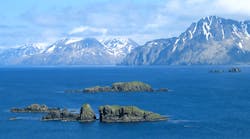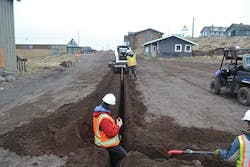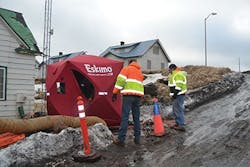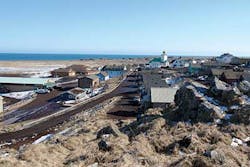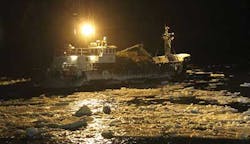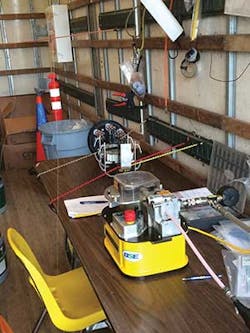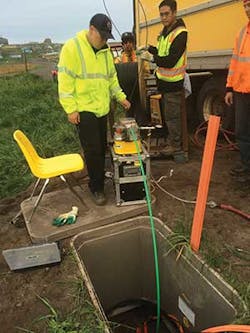Where History, Ecotourism, and Technology Meet
by: Ted Clemens
OSP Magazine
240 miles north of the Aleutian Islands, 300 miles west of the Alaska mainland, and a million miles
from the ordinary lies Saint Paul Island. The largest of the Pribilof Islands, St. Paul is a tiny volcanic island located in the Bering Sea — in the middle of the Northern Pacific Ocean — home to two-thirds of the world’s northern fur seal population, and the largest Aleut Native American community in the world.
You won’t find white sand beaches on St. Paul Island, or anyone wearing a bathing suit on the beach. You won’t find palm trees here either, or any trees for that matter. The yearly average temperature of +40° Fahrenheit (4.44° Celsius), and the yearly average snowfall of 56 inches (1.42 m), necessitates a warmer and more weather-resistant wardrobe. St. Paul is 40 square miles (64.3 k) of volcanic, sometimes hostile, sub-arctic ocean environment.
When describing St. Paul Island, the term sub-arctic is a relative term. Actually, St. Paul Island is a very hot place. Not "hot" in terms associated with volcanic activity. The last volcanic eruption here was in 1280 BCE. No, St. Paul Island is hot for different reasons.
St. Paul Island: An Economic Hotbed
St. Paul Island is home to the Central Bering Sea fishing fleet — the fishermen who troll the ferocious and dangerous Bering Sea for Alaska King and Snow Crabs. Immortalized by the popular reality television series, Deadliest Catch (see Sidebar below) chronicles the inherent high risk of injury or death associated with the work aboard fishing vessels during the Alaskan crab fishing season.
St. Paul Island is also the major hub of seafood processing for the Bering Sea’s "deadliest catch". Trident Seafood’s ultra-modern processing center — the largest crab production facility in the world — employs many of the 480 island inhabitants.
There is a viable Halibut fleet and commercial fishery on St. Paul Island as well. Halibut fishermen release mile-long, 1,000-hook, Long-Line fishing lines to catch fish. "Halibut fishing now provides annual employment to a significant number of local residents and has become a major contributor to the Saint Paul economy," explains Heather McCarty of Seafood.com. "Each year, 80 to 100 people of the community participate in the Halibut fishery, from the skippers to the boat crews to the young onshore hook baiters," she added.
A Hotbed of History and Ecotourism
Russian fur traders were the first non-natives to discover St. Paul Island in 1788. In the 18th Century, Russians forced the Aleuts from the nearby Aleutian Islands chain to hunt their seals. A few decades later, permanent communities were established in both St. Paul and nearby St. George Island, where the Aleut community lives to this day.
During Russian rule, and later under American rule (with the purchase of Alaska in 1867), the Aleut people were forced to live in servitude with no rights, like many other native American people at the time. They were cruelly exploited for their service in the fur seal industry. In June of 1942, the Japanese invaded the Aleutian Islands, landing on Attu Island and bombing Amaknak Island’s Dutch Harbor. As a result, the U.S. Government evacuated the Aleut people from St. Paul Island to southeast Alaska, where they were forced to live in internment camps under extreme and unbearable conditions.
Trenching operations on St. Paul Island.
Also called the "Galapagos of the North", St. Paul Island is the primary breeding ground for the northern fur seal, where about two-thirds of the world’s population (1.3 to 1.4 million) migrates annually. More than a quarter of a million seabirds exist on St. Paul, along with white foxes, blue foxes, and approximately 300 reindeer that also inhabit the island.
Infrastructure Problems
In addition to the crab processing and Halibut fishing, St. Paul Island is also home to the Tanadgusix Corporation (TDX). Owned by the Aleut Native American people on the island, TDX is one of several Alaska Native Corporations who, along with their subsidiaries, maintain a diversified group of worldwide operations. These include extensive property management and land stewardship businesses, environmental remediation contracting, fishing and seafood processing, urban and rural lodging, hotel ownership, eco-tourism, ground services, marine industry logistics, and more.
Adding heat to a splice tent.
TDX Power, the power production and distribution company on the island, operates Alaska’s largest hybrid wind-diesel power plant. Wind-diesel hybrid power systems combine diesel generators and wind turbines to generate electricity. They increase capacity and reduce the cost and environmental impact of electrical generation in remote communities and facilities, like St. Paul Island, not linked to a power grid.
In the early 1990’s, TDX first introduced cable TV to the island. Through satellite service provided by Dish Network, and an infrastructure of coaxial underground plant, life changed dramatically for the Aleut people. A very remote island with extreme weather much of the time, CATV provided a cherished source of information and entertainment. Later, Internet service was added.
Considered cutting-edge technology when first installed, the island’s coaxial network eventually proved to be unreliable. Called "Direct-bury 540 coax", its "flooding" feature, a water/moisture barrier inside the cable’s outer sheath, claimed to protect the copper wire from all elements.
As the island population grew, the cable network was being spliced continually as new connections were being added. Because the ground there is frozen rock solid for 5 months of the year, the freezing and thawing action causes the ground to shrink and swell over and over again. In such conditions, direct-buried coaxial cable can be compressed by ice. Then as the ground thaws, the cable may open in spots, causing the need for splicing repairs.
View of the village on Saint Paul Island on a sunny April day.
Another problem is damage to the cable caused by snowplows clearing the streets during the winter months. This also requires more splicing. If gaps in the splice exist, there is a potential for water seepage, where ice will form and diminish signal strength or worse: break the connection.
Aerial plant construction also offers no protection from cable damage due to the harsh weather conditions. Typical utility poles are planted about 10 feet in the ground. Gravity, plus the weight of power, telecom, messenger strands and CATV lines attached to it — all help to hold them in place. With just a single CATV line on each pole, there is not enough weight to help hold the pole in place. With the chronic hurricane-force winds that afflict the island here, ordinary utility poles would blow over.
The Kodiak battles huge waves while trying to shift its crab pots to give the boat more stability in rough seas.
Everywhere a coaxial cable splice exists the signal strength weakens at that spot. And when you consider the head end source of the signal (a satellite dish), the number of splice locations throughout the network, and the CATV signal and Internet data both fighting for bandwidth, there is a potential for considerable signal loss. Without the right amplifiers, you cannot boost the signal back to where it should be. Because of all of these reasons, TDX decided it was time to replace the coax network.
Laying the Groundwork
"Running fiber optics through Lite Access Technologies microduct(s) takes the whole issue of harsh environmental conditions — the signal degradation and splice problems — completely out of the equation," said Patrick Corey, Project Manager for Bering Sea Eccotech (BSE), and the man in charge of the entire Community Connect Broadband Infrastructure Upgrade project. Deploying a "7-millimeter direct-bury microduct, specially designed for all types of infrastructure and environmental conditions, is sturdy enough to withstand the swelling and freezing action of the ground while protecting the fiber," he explained.
Whale bones and crab pot marker floats.
Headquartered in Anchorage, Alaska, Bering Sea Eccotech (BSE), a wholly owned subsidiary of TDX, was awarded the task of replacing the entire coax cable network on the island. The Community Connect Broadband Infrastructure Upgrade project (called the St. Paul Fiber Project for short) calls for the installation of 300,000 linear feet (91,440 m) of air blown fiber in 2 phases.
Phase One is the construction phase. The construction phase started in 2011 and was completed by December 2014. Phase Two will be the 2-year "monitoring period" after the construction is completed. Two-hundred and six (206) locations (businesses and homes) are to be connected to the new fiber network on the island. BSE is placing 249,343 feet (76,000 m) of 4-count SM, 16,404 feet (5,000 m) of 72-count SM, and 13,123 feet (4,000 m) of 144-count SM fiber.
GMP Breeze Cable Blowing Machine inside of the box truck to blow in the 4-count fiber to the homes through the splice enclosure.
Starting with the consolidation points, or from the head end containing the equipment, every location terminates with a 4-count fiber drop. "We’re installing 7/3.5mm (0.28/0.14 inch) O.D. direct bury microduct at these locations," explained Corey. Intelligence Multi-Service Gateway (IMG) boxes, which access the Internet data and TV signal, are added to complete the installation at each location. Voice-over-Internet Protocol (VoIP) broadband telephone service will be included in the future.
When placing larger fiber counts, (72F and 144F), BSE uses an underground-rated, direct bury, 14/10mm (0.55/0.39 inch) O.D. microduct that allows for the 7.9mm (0.31 inch) fiber mini-cable to be "blown" into the system with ease. Having already successfully deployed the Lite Access technology in other remote and varied locations, it made complete sense to use Lite Access on St. Paul. "So, not only will the conduit and the fiber inside withstand the elements of cold, it will also withstand the heat, the ice, and all of the elements that we experience out here," Corey said.
Technician blowing fiber optic cable.
Micro-Trenching
BSE employs a micro-trench method of deployment leaving a mark you’d hardly notice. Being able to deploy in a narrow cut or micro-trench, the flexibility and adaptability of the microduct, and lack of heavy equipment, allows BSE to place cable up to 5 times faster than conventional means and at a fraction of the cost associated with traditional trenching.
BSE uses a Bobcat Model S770 Skid Steer Loader armed with a Caterpillar T9B chain trencher attachment for its slot trenching. This produces a trench about 6-8 inches (152 – 203 mm) wide, and to a depth of about 3 feet (0.91 m). Micro-trenching in most cities around the world typically cut 1 inch wide by 12-18 inches deep, speeding deployment and lower restoration time and cost.
Trenching in volcanic soil can be difficult. The island is made up of a highly vesicular, dark-colored rock called scoria. Corey can hit boulders the size of Volkswagen buses. Despite this, Corey is averaging approximately 400 feet (122 m) per day. "On a good day, we’ve covered as much as 1,400 feet (467 m). That included microduct to 9 homes plus activation," Corey recalled. "When you multiply the length of microduct and fiber times 9, minus the footages between the houses, we’ve dug, installed, activated and tested approximately 10,000 to 12,000 feet (3,048 to 3,657 m) in 1 day."
"All of our microduct and microfiber is supplied by Lite Access Technologies Inc. of Vancouver, British Columbia," stated Corey.
Hostile Terrain
Conventional conduit is large and rigid and typically requires wide, deep trenches to be dug before it can be installed. This task necessitates the use of large, powerful, and often expensive machinery. "The installation process is not only time-consuming but can also cause major traffic obstacles," said Michael Priest, President and Co-Founder of Lite Access Technologies (LAT).
LAT’s microduct and air blown fiber solutions are designed to solve any and all types of fiber connectivity including FTTH, long-haul/backbone, aerial, internal, and Last Mile applications. It is also flexible enough to bend and adjust to the undulations of the terrain. If necessary, it is so flexible it can be placed directly from a reel much like cable placement itself. As microduct is paid off the reel from the back of a moving truck or reel trailer, a contractor simply places the duct into the micro-trench and reinstatement can immediately commence.
Once the network is in place and reinstatement is complete, the fiber can then be blown into the duct within a matter of minutes. Being able to blow fiber after the civil work removes any issues with respect to potential damage of the fiber during construction and supports the future-proof fiber network solution offered by Lite Access.
Because the weather window of opportunity isn’t open for long, trenching and microduct placement has to be performed quickly. St. Paul Island enjoys 20 hours of daylight during the summer months. To take advantage of as much sunlight as possible, Corey’s crews work 12-16 hour shifts.
Like most places, you are always at the mercy of Mother Nature while working outdoors. But here on the island, weather fronts move in and out quickly — conditions can change hourly. "For the 7-month period when the ground has thawed deep enough for trenching (May to November), our typical workday may start out with a -30° Fahrenheit (-34.4° Celsius) wind-chill and 100-mph wind gusts," Corey explained. "Then 15 minutes later, we’ve got +40° Fahrenheit (4.44° Celsius), the wind has quieted down, and the sun is shining," he added.
Once the microduct is in place, and reinstatement is complete, Corey‘s team installs the fiber into the microduct using compressed air and a blowing machine. Corey prefers blowing fiber cable rather than pulling it. Because the fiber is so fragile, the friction created by pulling cable could damage it. By adding a cushion of air, or blowing, the friction level is not only reduced, but the entire placement process goes faster. To blow-in the fiber, BSE chose the Breeze Micro Fiber Cable Blowing Machine (the Breeze) by General Machine Products Company (GMP) of Trevose, Penn.*
"When blowing operations started in early March, we were working out of our Mobile Fiber Splicing & Blowing Vehicle, a 26 ft. Freightliner Box Truck. We had 5 feet of snow on the ground and the temperature was negative degrees," Corey recalled. "Using this tactic we’ve blown over 20,000 feet (6,096 m) of fiber using it in similar weather conditions," he said.
The Right Man for a Tough Job
There aren’t many who are as qualified to manage a project like this. Yet Patrick Corey is perfectly suited and comfortable in his role as Renaissance Man. A project such as this, in a place such as this, requires such a person. From lineman in California to the Google/Stanford University fiber project manager to his current job title of project manager, construction manager, safety coordinator, and fiber-tech trainer, Mr. Corey’s resume reads like a professional who’s experienced every facet of the telecommunications trade.
"I specialize in the placement of fiber optics," Corey said. "My job now is to do everything from the actual construction, to the project management, to safety control. I do fiber splicing and I train guys to splice fiber. I basically do everything from the digging, to cable installation, to the activation," he explained.
Another challenge that Corey faces is the stiff competition for qualified workers with other businesses on the island. Businesses like Trident Seafood, the largest seafood company in the United States, and TDX Power. There is also a major harbor construction project going on now. So, there are a lot of employment opportunities here for a sparse workforce.
One aspect of Mr. Corey’s job that is so vital to the success of the project is his respect and understanding of the island culture and the Aleut people he works with. "Not only are we putting people to work out here, but we’re upgrading their Internet and cable TV service," Corey observed. "To them, it’s all very important. We’re giving back. You know, it’s not just a job for me. It’s the whole process."
Marshaling a technically trained workforce drawn from a provincial community is no easy task. "We’ve got to set up all the COYOTE® domes. Then, there are the splice trays. We’ve got to strip all the fibers and clean them," Corey explained. "There’s a specific way to do all of this. You need people who are properly trained to make this happen," he added.
Because of BSE and Lite Access and GMP and Patrick Corey, the Aleut Native American people on St. Paul Island can be proud of their new fiber infrastructure when completed — a degree of fiber quality other parts of the US still do not yet have. And when you sit down to enjoy the next episode of Deadliest Catch, think of the Aleut people on St. Paul Island. Know that the crab pot lines and Halibut Long-Lines and 300,000 feet of fiber optic lines are all untangled, working, and running free.
Visits From Deadliest Catch
With 40 cameras per boat, and a 4- or 5-man film crew that shadow each boat, the popular reality television series Deadliest Catch, produced by Original Productions and distributed by the Discovery Channel, chronicles the inherent high risk of injury or death associated with the work aboard fishing vessels as they troll the Bering Sea and North Pacific for Alaska King and Snow Crab.
Deadliest Catch premiered on the Discovery Channel on April 12, 2005, and currently airs in over 200 countries. The first season consisted of 10 episodes, with the finale airing on June 14, 2005. Subsequent seasons have aired on the same April-to-July schedule every year since the original 2005 season. The 10th season debuted on April 22, 2014.
"I’ve met Sigurd Jonny "Sig" Hansen, the Captain of the fishing vessel Northwestern and one of the fishing teams featured on the documentary series," said Patrick Corey, Project Manager for Bering Sea Eccotech. Corey has also met Josh Harris who owns the Cornelia Marie, another fishing boat also featured in the series. "They are really nice guys and really hard workers," he added.
When the crab fishermen storage holds are full, and so they don’t have to travel the 270 miles back to their home port of Dutch Harbor on Amaknak Island. St. Paul Island and the Trident Seafood Company, the largest seafood company in the United States, offers an ultra-modern processing center there for the fishermen to offload their catch.
On huge, seagoing barges, the Northland Company transports the shipping containers, to and from the mainland, that are used by Trident Seafood to store and deliver their processed goods.
There is no rest for the weary, however. There are actually 2 crab fishing seasons, the October King Crab season and the January Snow Crab (or Opilio Crab) season. When all the fishing boats have offloaded their catch, they immediately return to sea and continue fishing until their holds are full and quotas are reached.
About Bering Sea Eccotech
Headquartered in Anchorage, Alaska, Bering Sea Eccotech (BSE) is a wholly owned subsidiary of Tanadgusix Corporation. Its areas of expertise include the Environmental/Hawaii Services Division that provides a comprehensive package of industrial cleaning and environmental services. BSE’s Fiber & Cable Division is a full service fiber optic and copper cable installation contractor that specializes in air blown fiber solutions. For more information, please visit www.bseak.com or call 907.278.2311.
About Tanadgusix Corporation
The Tanadgusix Corporation (TDX) is an Alaska Native Corporation representing St. Paul Island. TDX and its subsidiaries are a diversified and varied business operation. The business portfolio and experience includes extensive property management and land stewardship in a pristine marine environment as well as environmental remediation contracting. For more information, please visit www.tanadgusix.com or call 907.243.2233.
About Lite Access Technologies Inc.
Lite Access Technologies Inc. is a Vancouver-based fiber optic technology organization focused towards delivering a revolutionary microduct and air blown fiber solution that is swiftly changing the way fiber optic networks are deployed today. Lite Access’s unique suite of air-blown fiber technologies enables the end user to bridge the digital divide providing unlimited bandwidth in the most cost effective, timely and future-proof manner. For more information, please visit http://www.liteaccess.com or call 604.247.4704.
About General Machine Products Company
Celebrating more than 75 years of manufacturing and engineering excellence, the General Machine Products Company, Inc. (GMP) is a global provider of a wide range of products for the telecommunications, power utility and cable television industries, and the contractors who serve them. Product applications include the placement of fiber optic, copper conductor, and coaxial cable both aerially and underground. For more information, please visit www.gmptools.com or call 215.357.5500.
*Made in the U.S.A., the Breeze has grown to become a popular option not only among cable placement contractors in North America, but also throughout the world. It provides up to 35 pounds (15.88 kg) of pushing force — and has an adjustable 0 to 164 ft./min. (0 to 50 m/min.) speed control. The double-drive, self-centering cable rollers provide excellent pushing grip on micro fibers — even at sub-zero temperatures. It is designed to place 1 to 8.5 mm (0.04 to 0.33 inch) diameter fiber cable.
Ted Clemens is the Director of Sales for the General Machine Products Company (GMP). Ted was originally responsible for GMP sales in the Northeastern U.S., and subsequently held the titles of Senior Sales Representative and Sales Manager. He joined GMP in 1986 after working for 2 years for Graybar Electric in New York and Los Angeles. Ted can be reached by email at [email protected]. For more information about GMP, please visit http://gmptools.com.




